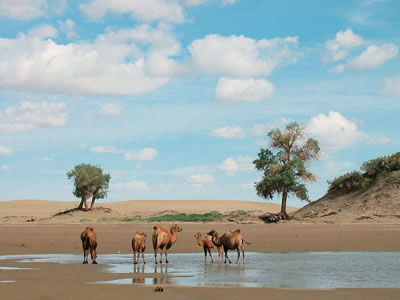Historical Evolution of the Adaptability in an Oasis Region to Water Resource Changes
The Oasis Project is a research project aiming at reconstructing the history of the interaction between people and nature for the last 2000 years in a Chinese arid region. The project adopts a trans-disciplinary approach, integrating the studies of history, archeology, ethnology, economics, hydrology, meteorology, climatology, glaciology, biology, and agriculture. The major research field has been in and around the Heihe region in central Eurasia, where outstanding human cultures have developed for the last 2000 years.
Research Content
constructed by examining historical documents, and a variety of proxies such as ice cores from glaciers, tree-ring samples, and lake sediment cores. The water circulation system in the basin, water resources and demands placed on them has been also studied.
The Outline of the Research Results
The Heihe Basin is a region where farming was developed by numerous colonial soldiers sent there to confront the Huns during the Han Dynasty 2000 years ago. At that time, the area of the Juyanze Lake was as large as 1600 km2. The lake area started decreasing thereafter, and this is considered to be due to the development of irrigated farmland. Thereafter, the region's population fell temporarily, but increased during each of the following dynasties: Tang, Xixia and Yuan.
Three-dimensional views helped identify the geographical extent of the agricultural lands around Kara Khoto during the Xixia and Yuan Dynasties in the period when Kara Khoto flourished. It was approximately twice the size of the modern Ejina Oasis. Ice core analysis showed that the air temperature from the end of the Yuan through the early Ming dynasties gradually fell. In other words, the volume of river flow per annum became less than the total annual precipitation concomitant with the growth of the glaciers due to the cooling effect.
Also, it became clear that many large-scale water routes were constructed during the Yuan Dynasty, and were used to develop vast tracts of agricultural land. This development of farmland definitely increased the volume of water drawn from the river around the oases, and consequently the downstream region of Kara Khoto was visited with water shortages.
 | |
| Photo The river bed on the Heihe in 2002, where no water is flowing at all. | |
At present, water shortages are again evident. Nearby vegetation is on the verge of crisis. Juyanze is also a shadow of its former self. The cause, basically, is the increase in the volume of water drawn from the river for irrigation farming at the oases, since water supply from the mountains has increased lately.
Two countermeasures to this problem have been established: forestation, and limits to the water drawn from the river in the mid-flow basins. Accordingly oasis farmers, for whom the volume of water they can take has been reduced, have come to dig wells to use the subterranean aquifers to augment their shortages in order to maintain their arable land. For forestation, a policy of “Ecological Relocation”, in which herdsmen from the foothills of the mountains are moved to the area around the oasis, has been adopted. The displaced herdsmen, however, have to develop fresh arable land to graze their animals. Although only natural, their new farming regions need water. Hence, the oases need more water now than ever, and shallow wells in the downstream area and even around the midstream region of Zhangye have started to dry up. To supplement this, an abundance of deep wells are now being dug. The water, however, has started to be used in abundance. This is considered the major problem at the moment.
In the Heihe Basin, people have solved the problem of water shortages caused in the region (system) where they live, by expanding the area of the system. Drawing irrigation water from upstream of the Heihe River expands the area on which their livelihoods depend.
Recently, however, surface water has all been used up, and the system has been expanded to include the subterranean world as well. This fact also means that the range of the system on which people's livelihoods depends has expanded to a global scale. That is to say, our system has expanded as far as it can go, and it can only be said that we have now reached an era in which existing methods for solving problems by expanding the range of a system can no longer be used.
We have to find, therefore, completely different methods for solving problems that do not rely on solutions based on expanding the existing system. We are living in just such an age.

